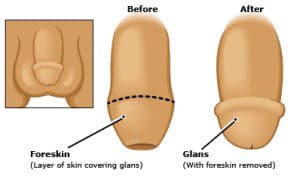 Circumcision is the process where the foreskin surrounding the end of the penis is removed. While the procedure is most commonly performed during childhood, more and more adult men in Los Angeles have opted to get circumcised in recent years for a variety of reasons, including religious, medical, and cosmetic/aesthetic.
Circumcision is the process where the foreskin surrounding the end of the penis is removed. While the procedure is most commonly performed during childhood, more and more adult men in Los Angeles have opted to get circumcised in recent years for a variety of reasons, including religious, medical, and cosmetic/aesthetic.
The procedure for a medical or cosmetic adult circumcision is fairly straightforward. A urologist performs the circumcision on an outpatient basis in Los Angeles, which typically takes between 30 to 45 minutes, with the option for light sedation or a local anesthetic. The most common method used is the freehand cut, which uses two incisions, followed by suturing the edges of the skin.
Potential Health Benefits of Circumcision
The reasons for choosing to remove the foreskin as an adult vary from patient to patient and usually involve a combination of factors. Getting circumcised as an adult can have several health benefits, including:
Reduction/Prevention of Certain Sexually Transmitted Diseases (STDs) and Urinary Tract Infections (UTI) in Men
Specifically, research has shown that circumcised men have a significantly lower risk of contracting HIV, Syphilis, and chancroid (an infection that can cause ulceration of the lymph nodes in the groin). Researchers believe that cells in the foreskin can potentially make it easier to transmit the HIV virus. It can also create a moist environment more prone to bacterial infections, which can also spread to the urinary tract. Removing the foreskin can reduce the risk of urinary tract infections in men by as much as 10-14% according to statistics.
Prevent Paraphimosis and Balanoposthitis
Paraphimosis is a painful condition that causes swelling around the penis due to restricted blood flow if the foreskin becomes stuck under the tip of the penis. The condition can potentially lead to penile tissue death in some cases.
Balanoposthtis results from a bacterial infection and causes inflammation of the foreskin. Symptoms include pus and pain during urination.
Lower Risk of Penile Cancer
Although extremely rare, penile cancer cells tend to originate in the foreskin according to research. Circumcision can reduce the risk of developing penile cancer by as much as 3-4 times, and serves as a preventive measure for men with a family history of the disease.
What to Expect Before and After Adult Circumcision
 Like the procedure itself, preparing for a circumcision at Comprehensive Urology in Beverly Hills is fairly simple and straight forward. Patients are advised to trim the pubic hair as much as possible before the procedure in order to prevent irritation and infection after the procedure.
Like the procedure itself, preparing for a circumcision at Comprehensive Urology in Beverly Hills is fairly simple and straight forward. Patients are advised to trim the pubic hair as much as possible before the procedure in order to prevent irritation and infection after the procedure.
Patients are advised to avoid alcohol and drug use (unless prescribed) at least 24 hours before the appointment. Alcohol consumption can cause dehydration and potentially limit the effectiveness of anesthesia.
Patients choosing to undergo the procedure under light sedation are advised to eat a light meal the night before; general anesthesia requires fasting.
Patients should clean the groin area thoroughly before the procedure, and be sure to urinate and empty the bowels completely.
Adult Circumcision Recovery
After the circumcision, the penis will be bandaged in order to manage swelling and to help protect the incisions where the foreskin was removed. However, the healing process will be quick due to the minimally invasive techniques used. While urination after the penis is circumcised does not typically cause pain, there could be spraying in the first few days after the procedure.
Sexual activity can typically resume after six weeks in order to allow the incisions to heal properly and to prevent tearing of the incision and bleeding. In order to help minimize erections while sleeping, men are advised to empty the bladder before bed, and to sleep on the side or in the fetal position.
Using a condom after the six-week period until the wound is fully healed can help to avoid painful friction and irritation of the scar.
Tylenol is usually recommended for managing pain after a circumcision. (Aspirin can cause excessive bleeding and should not be used.)
Preventing Infectious Risks
 While often a hot-button topic, male circumcision can be more than just a cultural, religious or cosmetic decision. Many adult men actually choose to have the foreskin removed from the end of the penis as a preventative measure against recurrent infections and even sexually transmitted diseases. However, many do not fully understand the potential risks that can be averted through choosing adult circumcision. By understanding these infections and other conditions, you can make informed choices about your own urological health.
While often a hot-button topic, male circumcision can be more than just a cultural, religious or cosmetic decision. Many adult men actually choose to have the foreskin removed from the end of the penis as a preventative measure against recurrent infections and even sexually transmitted diseases. However, many do not fully understand the potential risks that can be averted through choosing adult circumcision. By understanding these infections and other conditions, you can make informed choices about your own urological health.
Dr. Kia Michel and his team of board-certified urologists at Comprehensive Urology have extensive experience performing circumcisions, as well as treating common infections and conditions that occur as a result of poor foreskin hygiene or foreskin problems.
Preventing Foreskin and Urinary Infections
The inner part of the foreskin is a mucus membrane, not unlike the inside of the eyelid, which helps keep the glans at the end of the penis naturally lubricated. However, bacteria can build up underneath the foreskin, leading to infections and urinary tract infections without proper hygiene. Some men have difficulty keeping the foreskin clean if the foreskin is too tight to be retracted (a condition called phimosis) or has slid down and cannot be lifted to cover the glans (paraphimosis).
The most common types of infections and issues associated with foreskins include:
Urinary Tract Infections (UTIs) – An infection of the urinary system due to bacteria build up under the foreskin. While most UTIs are relatively mild, the symptoms, such as pain during urination or frequent urination, can be uncomfortable. Persistent UTIs can even lead to serious infections of the kidney.
Balanitis – Inflammation of the foreskin due to a bacterial infection that also causes pain when urinating, itchiness, and an unpleasant odor. While antibiotics and creams may treat the condition, circumcision may be prescribed as not only a preventative measure, but also the only permanent solution to a patient’s balanitis.
Posthitis – Inflammation of the foreskin that causes swelling, redness, and an unpleasant smelling discharge caused by bacteria or fungus. It can also be caused by an allergic reaction to irritants or sexually transmitted diseases, such as chlamydia and gonorrhea.
Balanoposthitis – Inflammation of both the foreskin and the glans at the end of the penis as a result of bacterial or fungal infection or contact dermatitis, leading to soreness, irritation, discharge, rashes, and more. Circumcisions are often prescribed in recurrent cases.
Sexually Transmitted Diseases – The foreskin is believed to increase the risk of catching STDs due to the mucous membrane lining the inner tissue, which may allow certain germs and bacteria to penetrate the skin. The foreskin may even prolong the amount of time that the sensitive skin at the glans remains moist, encouraging bacterial growth.
While many uncircumcised men do not experience any issues with their foreskin, in the event of frequent infections and issues, circumcision may be recommended as a preventative measure.
Cosmetic
 While the majority of circumcisions are typically performed on infants or young children, many adult men choose to have their foreskin surgically removed for cosmetic reasons, such as correcting complications from a previous circumcision or removing redundant foreskin. While there are many benefits behind adult circumcision, cosmetic circumcisions can provide a patient with the appearance and comfort that they desire.
While the majority of circumcisions are typically performed on infants or young children, many adult men choose to have their foreskin surgically removed for cosmetic reasons, such as correcting complications from a previous circumcision or removing redundant foreskin. While there are many benefits behind adult circumcision, cosmetic circumcisions can provide a patient with the appearance and comfort that they desire.
Dr. Kia Michel and the skilled cosmetic urologists at Comprehensive Urology have extensive training and experience performing adult circumcisions and are able to achieve amazing results with skill and precision. To discuss whether circumcision can give you the aesthetic results you want, please do not hesitate to contact Comprehensive Urology today. A consultation can provide you with a greater understanding of the benefits of cosmetic urology for your unique needs.
Cosmetic Circumcisions and Revisions
It is not uncommon for uncircumcised adult men to undergo circumcision in order to achieve a smoother appearance of the penis, especially when erect. In the United States, the majority of males are still circumcised at birth, causing those who have not been circumcised to feel self-conscious of the appearance of their penis, regardless of function. At Comprehensive Urology, our patients are highly satisfied with the clean, smooth results our urologists can achieve through adult circumcision.
Other common cosmetic reasons that adult men choose circumcision include:
Redundant Foreskin – Also known as an incomplete circumcision, redundant foreskin occurs when the total foreskin is not removed during circumcision, leaving extra tissue around the end of the penis. Even partial foreskin can be vulnerable to bacteria build up and infection, in addition to looking different than uncircumcised and properly circumcised penises.
Too Much Skin Removal – While rare, some pediatricians accidentally remove too much skin when performing a circumcision, especially on infants, causing deformity. In severe cases, skin grafts may be used to reconstruct the lost tissue in order to create a normal looking penis, no matter the length of time since the original procedure.
Adhesions – Preputial adhesions occur when redundant foreskin is left behind after an incomplete circumcision, causing the skin to reattach to the glans (head of the penis). While adhesions are typically benign, they can become infected due to poor hygiene. Adult men often chose to have the glanular adhesions removed to achieve a smooth, normal looking penis.
What to Expect During the Circumcision Procedure
Circumcision is a safe, simple procedure that can be performed under local anesthesia. After applying a topical anesthetic or injecting numbing agents into the penis, Dr. Michel or one of the urologists at Comprehensive Urology in Los Angeles will use specialized clamps or devices to carefully retract the foreskin from the glans before trimming off the excess skin. There will be small, absorbent sutures used to close the incisions. Patients can then return home after the procedure. The most common side effects include swelling, soreness, and bruising, which should disappear in a short amount of time.
Contact an Experienced Urologist in Beverly Hills Today
Are you considering getting an adult circumcision in Los Angeles and want more information about the procedure and whether it is right for you? Call (310) 499-2756 to contact an experienced urologist at Comprehensive Urology, and to schedule a consultation.
Next, read about Vasectomy.